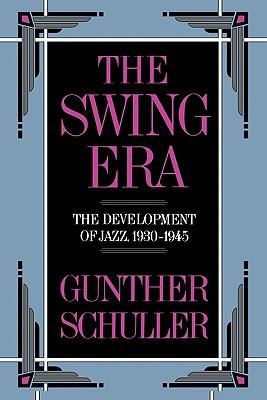
Book
The Swing Era: The Development of Jazz, 1930-1945
(Write a Review)
Paperback
$36.93
The Swing Era focuses on that extraordinary period in American musical history--1933 to 1945--when jazz was synonymous with America's popular music, its social dances and musical entertainment. The book's thorough scholarship, critical perceptions, and great love and respect for jazz puts this well-remembered era of American music into new and revealing perspective. It examines how the arrangements of Fletcher Henderson and Eddie Sauter--whom Schuller equates with Richard Strauss as "a master of harmonic modulation"--contributed to Benny Goodman's finest work...how Duke Ellingtonp used the highly individualistic trombone trio of Joe "Tricky Sam" Nanton, Juan Tizol, and Lawrence Brown to enrich his elegant compositions...how Billie Holiday developed her horn-like instrumental approach to singing...and how the seminal compositions and arrangements of the long-forgotten John Nesbitt helped shape Swing Era styles through their influence on Gene Gifford and the famous Casa Loma
Orchestra. Schuller also provides serious reappraisals of such often neglected jazz figures as Cab Calloway, Henry "Red" Allen, Horace Henderson, Pee Wee Russell, and Joe Mooney.
Much of the book's focus is on the famous swing bands of the time, which were the essence of the Swing Era. There are the great black bands--Duke Ellington, Count Basie, Jimmie Lunceford, Earl Hines, Andy Kirk, and the often superb but little known "territory bands"--and popular white bands like Benny Goodman, Tommy Dorsie, Artie Shaw, and Woody Herman, plus the first serious critical assessment of that most famous of Swing Era bandleaders, Glenn Miller. There are incisive portraits of the great musical soloists--such as Art Tatum, Teddy Wilson, Coleman Hawkins, Lester Young, Bunny Berigan, and Jack Teagarden--and such singers as Billie Holiday, Frank Sinatra, Peggy Lee, and Helen Forest.
The Swing Era focuses on that extraordinary period in American musical history--1933 to 1945--when jazz was synonymous with America's popular music, its social dances and musical entertainment. The book's thorough scholarship, critical perceptions, and great love and respect for jazz puts this well-remembered era of American music into new and revealing perspective. It examines how the arrangements of Fletcher Henderson and Eddie Sauter--whom Schuller equates with Richard Strauss as "a master of harmonic modulation"--contributed to Benny Goodman's finest work...how Duke Ellingtonp used the highly individualistic trombone trio of Joe "Tricky Sam" Nanton, Juan Tizol, and Lawrence Brown to enrich his elegant compositions...how Billie Holiday developed her horn-like instrumental approach to singing...and how the seminal compositions and arrangements of the long-forgotten John Nesbitt helped shape Swing Era styles through their influence on Gene Gifford and the famous Casa Loma
Orchestra. Schuller also provides serious reappraisals of such often neglected jazz figures as Cab Calloway, Henry "Red" Allen, Horace Henderson, Pee Wee Russell, and Joe Mooney.
Much of the book's focus is on the famous swing bands of the time, which were the essence of the Swing Era. There are the great black bands--Duke Ellington, Count Basie, Jimmie Lunceford, Earl Hines, Andy Kirk, and the often superb but little known "territory bands"--and popular white bands like Benny Goodman, Tommy Dorsie, Artie Shaw, and Woody Herman, plus the first serious critical assessment of that most famous of Swing Era bandleaders, Glenn Miller. There are incisive portraits of the great musical soloists--such as Art Tatum, Teddy Wilson, Coleman Hawkins, Lester Young, Bunny Berigan, and Jack Teagarden--and such singers as Billie Holiday, Frank Sinatra, Peggy Lee, and Helen Forest.
Paperback
$36.93